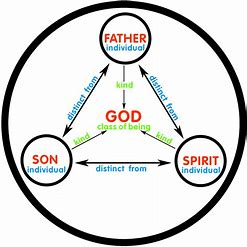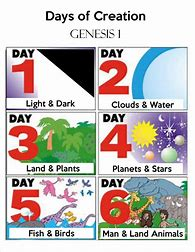Catholic Christianity
Catholic Christianity
Key Beliefs in Catholic Christianity
The Trinity:
The Trinity can help Christians to gain a deeper understanding of God and of how he can be all the things that the Bible suggests. Christians believe in One God but he exists in three persons:
God the Father
God the Son, also known as Jesus Christ
God the Holy Spirit

Old testament
In the Old Testament, it is made clear that there is only one God:
Deuteronomy 6:4-5 “Hear, O Israel: The Lord is our God, the Lord alone.”
1 Kings 8:60 “That all the peoples of the earth may know that the Lord is God; there is no other.”
New Testament
The oneness of God is revealed through scripture. In the New Testament the doctrine of the Trinity describes how there is one God who exists as three divine persons. Christians believe that God the father provides sustainability to the world and is a voice from above. God the Son (Jesus Christ) is both divine and human. He is a model for Christian behavior and a savior. Also, God the Holy Spirit is the presence of God in the world, often a symbol of a dove.
“Jesus … saw the spirit of God descending like a dove and alighting on him. And a voice from heaven said, ‘This is my Son, whom I love; with him I am well pleased.’” — Matthew 3:16–17
The Holy Spirit is the love that unites the Father and the Son: Galatians 4:6 “And because you are children, God has sent the Spirit of his Son into our hearts, crying, ‘Abba! Father!’”
The Nicene Creed
Church leaders gathered and created the Nicene Creed at the Council of Nicaea in AD325. The council was called by the Emperor Constantine. This was a very important meeting because those who attended decided on the divine nature of Jesus and his relationship to God the Father.
Three forms or three persons
The Nicene creed shows there is one God that exists in three forms or three persons:
God the Father is the creator of all things.
Jesus Christ, as God the Son, suffered and died as a fully human being to save other humans from sin. Jesus rose from the dead and now seats in Heaven as the Son of God.
God the Holy Spirit gives life to all things. The Holy Spirit guides people to the will of God.
The Creation
Genesis is the first book of the Bible. The first two chapters deal with creation: Genesis 1 describes the creation of the earth, while Genesis 2 focuses on the creation of the first humans, Adam and Eve.
Genesis 1
In Genesis 1, Christians find the story of how God created the world. They also find the order of his creation. It says:
God is the only creator.
God existed before he created the world.
The world was well planned and is sustained by God.
God blessed creation; all creation is holy.
God created everything in Heaven and on Earth in six days.
On the seventh day, God rested.

The incarnation of Jesus
The incarnation of Jesus was when God took on human form, becoming fully God and fully human at the same time. Jesus was fully human. Christians believe that he lived his life like any other human and felt emotions like every human. This shows that God sent his son down to earth to pay for the sins of humans as Jesus Christ did feel everything. He suffered pain at his crucifixion, and his ability to acknowledge human suffering was only possible because he was fully human.
Virgin mary
Christians believe that the Virgin Mary was visited by the Angel Gabriel, who told her that she was to have a son and he would be named Jesus.
“For the child conceived in her is from the Holy Spirit. She will bear a son, and you are to name him Jesus, for he will save his people from their sins.”— Matthew 1:20–21
Jesus’ death and resurrection
Death
He was taken to see Pontius Pilate, the Roman governor who was responsible for deciding who could be put to death. Pilate wanted to release Jesus and presented him to the crowd in the hope that they would want him to be freed.
However, they chanted ‘crucify him’ because they were heavily influenced by the religious leaders who wanted Jesus to be executed. Pilate was therefore pressured into sentencing Jesus to be crucified. The crowd also said that Barrabas should be released and Jesus should be placed in his place.
Jesus was flogged and crucified at the site of Golgotha on the day that Christians know as Good Friday. Jesus suffered on the cross for over six hours and called out My God, my God, why have you forsaken me?
Mark's gospel states that the sky then turned dark, and darkness fell over the land for the last three hours of Jesus' life. At the moment when Jesus died, the temple curtain ripped in two, which Christians understand to be a sign from God to show that Jesus’ death had atoned for the sins of humanity.
Jesus was betrayed by his disciple and friend, Judas Iscariot. Jesus was arrested in the Garden of Gethsemane. He was then by the high priests and found guilty of blasphemy and false prophesying.
Resurrection
After his death, Jesus’ body was taken down from the cross and placed into a rock tomb with a heavy stone covering its entrance. Jesus’ death teaches Christians that God is with humans even when they die. When his female followers, including Mary Magdalene, visited the tomb the Sunday after his crucifixion, they saw that the stone had been rolled away from its entrance. Inside, Jesus’ body was missing. Mary Magdalene returned to the disciples to tell them the news that Jesus had risen from the dead. Christians call these events the resurrection of Jesus.
Redemption and life after death
Redemption is a key Christian belief in the idea that humanity can be saved from sin - redeemed - through the actions of Jesus. Jesus is often described as the Example, the Restorer or the Victor
The Example - Jesus acted as a model of perfect human behavior, living without sin. Even when suffering at his crucifixion, he showed compassion and forgiveness towards his executioners. This shows that Jesis is the ultimate example for other Christians.
The Restorer - Jesus broke the barrier between God and humanity when he died, atoning for the sins of humankind and repairing the humans' relationship with God which had been broken by sin.
The Victor - Jesus was victorious over pain and death. Jesus showed this by healing people, but ultimately through the miracle of the resurrection
Salvation
Following the mistake made by Adam and Eve that led to evil entering the world, God offered salvation. In Christianity, salvation allows a human soul to be saved from death and allowed to enter Heaven.
How did Jesus’ death lead to salvation?
God gave his only son, Jesus so that humans could be saved.
Jesus was a perfect human - he had no sin.
God placed the sins of the world upon him at his crucifixion.
Jesus’ actions meant that there was reconciliation between God and humanity - his death made up for human sin.
Life after death
Christians believe that, following the physical death of the body, the soul lives on. This is known as the immortality of the soul.
Christians believe in the resurrection of the body on a Day of Judgement, when God will judge everyone individually and they will be sent to Heaven or Hell.
Catholics believe in a place called Purgatory, where sins are punished and where a person’s soul undergoes purification before it can go to Heaven.